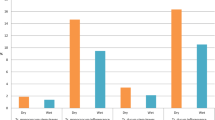Abstract
We present a new extraction method for opal phytoliths, which has high potential to support qualitative analyses of the unaltered properties of single opal phytoliths. Opal phytoliths have to remain in their original solution or an equivalent to protect their amorphous (SiO2 nH2O) molecular structure. Fresh leaf material was heated in distilled water in a microwave oven for 3–4 hours, stirred and then strained through a plankton sieve (50-μm mesh). After purification, the plant tissue matrix was successfully degraded. Single opal phytoliths of Phragmites australis and Arundo donax as well as cell debris were isolated.
Similar content being viewed by others
References
Blackman E. 1968. The Pattern and Sequence of Opaline Silica Deposition in Rye (Secale cereale L.). Ann. Bot. 32: 207–218.
Bowdery D. 1989. Phytolith Analysis: Introduction and Applications, pp. 161–196. In: Beck W., Clarke A. & Head L. (eds), Plants in Australian archaeology, University of Queensland — Anhtropology Museum, Queensland.
Currie H.A. & Perry C.C. 2007. Silica in plants: Biological, biochemical and chemical studies. Ann. Bot. 100: 1383–1389.
Epstein E. 1999. Silicon. Annu. Rev. Plant. Physiol. Plant. Mol. Biol. 50: 641–664.
Grundhöfer H. 1994. Einfluß von Silikataufnahme und -einlagerung auf den Befall der Rebe mit Echtem Mehltau. Dissertation, University of Hohenheim, Hohenheim.
Hodson M.J. & Evans D.E. 1995. Aluminium/silicon interactions in higher plants. J. Exp. Bot. 46: 161–171.
Jones L.H.P. & Milne A.A. 1963. Sudies of silica in the oat plant: I. Chemical and physical properties of the silica. Plant Soil 18: 207–220.
Kappe C.O. 2004. Controlled microwave heating in modern organic synthesis. Angew. Chem. Int. Ed. 43: 6250–6284.
McNaughton M.M. & Tarrants J.L. 1983. Grass leaf silicification: Natural selection for an inducible defense against herbivores. Proc. Natl. Acad. Sci. USA 80: 790–791.
Ma J.F. & Yamaji N. 2006. Silicon uptake and accumulation in higher plants. Trends Plant Sci. 11: 392–397.
Parr J.F., Dolic V., Lancaster G. & Boyd W. E. 2001a. A microwave digestion method for the extraction of phytoliths from herbarium specimens. Rev. Palaeobot. Palynol. 116: 203–212.
Parr J.F., Lentfer C.J. & Boyd W.E. 2001a. A comparative analysis of wet and dry ashing techniques for the extraction of phytoliths from plant material. J. Arch. Sci. 28: 875–886.
Piperno D.R. 1998. Paleoethnobotany in the Neotropics from microfossils: New insights into ancient plant use and agricultural origins in the tropical forest. J. World Prehist. 12: 393–449.
Piperno D.R. 2006. Phytoliths. A Comprehensive Guide for Archaeologists and Paleoecologists. Altamira Press, Lanham, 238 pp.
Pironon J., Meunier J.D., Alexandre A., Mathieu R., Mansuy L., Grosjean A. & Jarde E. 2001. Individual characterization of phytoliths: Experimental approach and consequences on paleoenvironment understandig, pp. 329–341. In: Meunier J.D. & Colin F. (eds), Phytoliths: Applications in Earth Sciences and Human History, Balkema Publishers, Lisse.
Prychid C.J., Rudall P.J. & Gregory M. 2004. Systematics and biology of silica bodies in monocotyledons. Bot. Rev. 69: 377–440.
Rosen A.M. & Weiner S. 1994. Identifying ancient irrigation: a new method ssing opaline phytoliths from Emmer wheat. J. Arch. Sci. 21: 125–132.
Runge F. 2000. Opal-Phytolithe in den Tropen Afrikas und ihre Verwendung bei der Rekonstruktion paläoökologischer Umweltverhältnisse. Books on Demand GmbH, Paderborn, 285 pp.
Author information
Authors and Affiliations
Corresponding author
Rights and permissions
About this article
Cite this article
Braune, C., Lieberei, R., Steinmacher, D. et al. A simple microwave extraction method for the isolation and identification of plant opal phytoliths. Biologia 67, 927–930 (2012). https://doi.org/10.2478/s11756-012-0074-1
Received:
Accepted:
Published:
Issue Date:
DOI: https://doi.org/10.2478/s11756-012-0074-1




